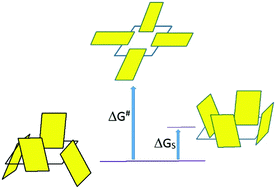Strain effects determine the performance of artificial allosteric systems: calixarenes as models
Abstract
It is shown that the performance of allosteric systems regarding the efficiency and the speed of response depends critically on the strain energy of the equilibrating conformers and of the corresponding interconversion transition state. The affinity of a substrate A can be large enough to overcome in the absence of an effector E by induced fit the strain involved in the formation of an optimal conformation for binding A. The efficiency as given by the ratio KAE/KA of binding constants in the presence or absence of an effector is, for many published synthetic allosteric systems, relatively low; in practice this means that these only function within rather limited concentration ranges. A small KAE/KA ratio means that the binding strength of A or the corresponding signal will increase only little by adding an effector, and may need higher concentration of E. Implementation of steric distortion in the minor conformer can lead to reduced binding of A in the absence of the effector E. Destabilization of conformers can also result from the inclusion of high energy water molecules within a cavity. Furthermore, until now it has been overlooked that strain in the transition state can lead to reaction times of up to days, and thus to the neglect of experimental observation. The role of conformational changes within an allosteric molecule is characterized with a variety of calixarenes and other compound classes, offering a clue for the design of more efficient synthetic systems with high cooperativity.



 Please wait while we load your content...
Please wait while we load your content...